Related Research Articles

The orca, or killer whale, is a toothed whale that is the largest member of the oceanic dolphin family. It is the only extant species in the genus Orcinus. Orcas are recognizable by their black-and-white patterned body. A cosmopolitan species, orcas are found in diverse marine environments, from Arctic to Antarctic regions to tropical seas.

A dolphinarium is an aquarium for dolphins. The dolphins are usually kept in a pool, though occasionally they may be kept in pens in the open sea, either for research or public performances. Some dolphinariums consist of one pool where dolphins perform for the public, others are part of larger parks, such as marine mammal parks, zoos or theme parks, with other animals and attractions as well.

Corky II, often referred to as just Corky, is a female captive orca from the A5 Pod of northern resident orcas. At approximately the age of four, Corky was captured from Pender Harbour off the coast of British Columbia on December 11, 1969. She has lived at SeaWorld San Diego in San Diego, California since 1987. As of 2023, she is the oldest and longest kept captive orca. SeaWorld San Diego celebrates her birthday on 2 January every year.

Marineland, is a themed zoo and amusement park in Niagara Falls, Ontario, Canada. The park has performing marine animal shows, exhibits of marine and land animals, and amusement rides. It keeps dolphins, sea lions, and beluga whales. Until 2023, the park also kept walruses and orcas. The park also keeps bears, deer, and other land animals. It was founded and operated by John Holer, a Slovenian immigrant, from 1961 until his death in 2018. It is privately owned and operated by his family.
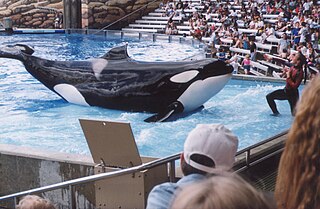
Katina is a female orca who lives in SeaWorld Orlando in Florida. She was captured off Iceland at approximately three years of age on October 26, 1978. She is the most successful breeding female orca in captivity.
Sealand of the Pacific was a public aquarium in South Oak Bay at The Oak Bay Marina, near the city of Victoria, in British Columbia, Canada. It housed a number of orcas: Haida, Nootka, and Tilikum. In 1991, all three were involved in an incident in which a trainer, Keltie Byrne, was killed. The aquarium subsequently closed and sold its orcas to SeaWorld.
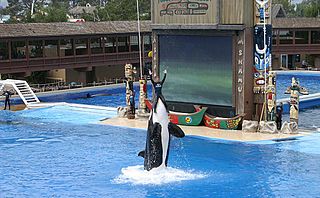
Kasatka was a wild caught female orca who lived at SeaWorld San Diego.

A marine mammal park is a commercial theme park or aquarium where marine mammals such as dolphins, beluga whales and sea lions are kept within water tanks and displayed to the public in special shows. A marine mammal park is more elaborate than a dolphinarium, because it also features other marine mammals and offers additional entertainment attractions. It is thus seen as a combination of a public aquarium and an amusement park. Marine mammal parks are different from marine parks, which include natural reserves and marine wildlife sanctuaries such as coral reefs, particularly in Australia.

The Marineland of Antibes is a theme park founded in 1970 by Count Roland de La Poype in Antibes (Alpes-Maritimes), in the French Riviera. Covering 26 hectares, it includes a marine zoological park with dolphinarium, a water park (Aquasplash), a children's play park, mini golf and a hotel. It is the property of the Spanish multinational company Parques Reunidos, whose majority shareholder is the British investment fund Arle Capital Partners. The current director is Arnaud Palu.
Orcas are large, powerful aquatic apex predators. There have been multiple killer whale attacks on humans in the wild, but such attacks are less common than those by captive orcas. In captivity, there have been several non-fatal and four fatal attacks on humans since the 1970s. Experts are divided as to whether the injuries and deaths were accidental or deliberate attempts to cause harm.

Springer, officially named A73, is a wild orca from the Northern Resident Community of orcas, which frequents the waters off the northern part of Vancouver Island every summer. In January 2002, Springer, then a calf developmentally equivalent to a human toddler, was discovered alone and emaciated some 250 miles from the territory of her family. Experts identified Springer by her vocal calls that are specific to her family, or "pod," and by examining photographs of her eye patch. They were also able to determine where Springer's pod was currently located.
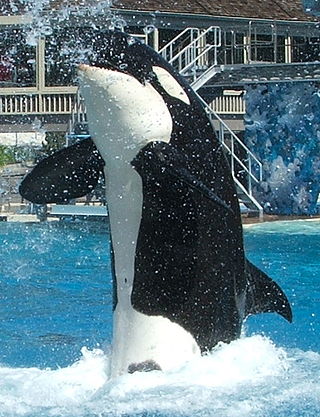
Dozens of orcas are held in captivity for breeding or performance purposes. The practice of capturing and displaying orcas in exhibitions began in the 1960s, and they soon became popular attractions at public aquariums and aquatic theme parks due to their intelligence, trainability, striking appearance, playfulness, and sheer size. As of 1 January 2024, around 58 orcas are in captivity worldwide, 34 of which were captive-born. At that time, there were 18 orcas in the SeaWorld parks.

The southern resident orcas, also known as the southern resident killer whales (SRKW), are the smallest of four communities of the exclusively fish-eating ecotype of orca in the northeast Pacific Ocean. The southern resident orcas form a closed society with no emigration or dispersal of individuals, and no gene flow with other orca populations. The fish-eating ecotype was historically given the name 'resident,' but other ecotypes named 'transient' and 'offshore' are also resident in the same area.

Tilikum, nicknamed Tilly, was a captive male orca who spent most of his life at SeaWorld Orlando in Florida. He was captured in Iceland in 1983; about a year later, he was transferred to Sealand of the Pacific in Victoria, British Columbia. He was subsequently transferred in 1992 to SeaWorld in Orlando, Florida, where he sired 21 calves throughout his life.

Ulises is a male orca who lives at SeaWorld San Diego in California. He was captured off the coast of Iceland in 1980 and is currently the oldest male orca in captivity as of 2022. SeaWorld San Diego celebrates his birthday on 1st January every year.

Alexandra Bryant Hubbard Morton is an American and Canadian marine biologist best known for her 30-year study of wild killer whales in the Broughton Archipelago in British Columbia. Since the 1990s, her work has shifted toward the study of the impact of salmon farming on Canadian wild salmon.
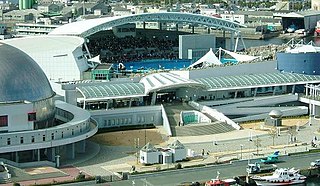
The Port of Nagoya Public Aquarium is a public aquarium in Minato-ku, Nagoya, Aichi Prefecture, Japan. It is the public aquarium with the largest tank capacity and total area in Japan. It also owns Japan's largest dolphin show tank.
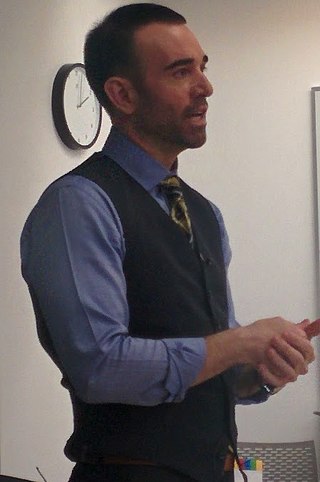
John Hargrove is a former senior killer whale trainer for SeaWorld and supervisor of killer whale training at Marineland of Antibes in France. Hargrove appeared in the 2013 documentary Blackfish, wrote a book about his experiences in Beneath the Surface, and has campaigned in support of legislation in California and New York to end the practice of keeping killer whales in captivity.
Tahlequah, also known as J35, is a killer whale of the southern resident community in the northeastern Pacific Ocean. She has given birth to three known offspring, a male (Notch) in 2010, a female (Tali) in 2018, and another male (Phoenix) in 2020. Her second calf, Tali, died shortly after birth and J35 carried her body for 17 days in an apparent show of grief that attracted international attention.
References
- ↑ Abramson, J. Z., Hernández-Lloreda, M. V., García, L., Colmenares, F., Aboitiz, F., & Call, J. (2018). Imitation of novel conspecific and human speech sounds in the killer whale (Orcinus orca). Proc. R. Soc. B, 285(1871), 20172171.
- ↑ Burton, Bonnie (February 2, 2018). "Killer whale recorded mimicking language". CNET. Retrieved April 28, 2018.
- ↑ "Wikie the killer whale says "hello," and that's not all". CBS News. January 31, 2018. Retrieved April 28, 2018.
- ↑ Mercer, David (January 31, 2018). "'Talking' killer whale Wikie should be freed from captivity, charities say". Sky News. Retrieved April 28, 2018.